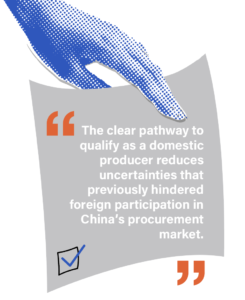
The implications of the ‘made in China’ price advantage
The introduction of an automatic 20 per cent price advantage on goods and services that meet certain domestic production standards when considering bids for public procurement contracts signals a decisive move to support domestic manufacturing. In this article, Giulia Interesse and Qian Zhou of Dezan Shira and Associates explore how this policy is anchored in the broader goals of the Made in China 2025 (MIC2025) initiative and how it is likely to impact European businesses.
China’s evolving procurement policies signal a decisive move to support domestic manufacturing while providing opportunities for both local and foreign enterprises operating in China.
On 5th December 2024, the Ministry of Finance (MOF) released the draft Notice on Matters Related to Domestic Product Standards and Implementation Policies in the Field of Government Procurement (Notice).[1] The Notice and its related annexes seek to:
- establish a clear definition for ‘domestic products’ used in government procurement;
- outline criteria and processes for determining eligibility for preferential policies; and
- ensure transparency and fairness for all types of enterprises participating in government procurement, including state-owned, private and foreign-invested businesses.
This policy initiative aligns with China’s strategic focus on modernising its government procurement systems to reflect global best practices while advancing domestic economic goals.
The introduction of an automatic 20 per cent price advantage for products that meet domestic production standards when considering bids for government procurement contracts, highlights the government’s intention to bolster local supply chains while maintaining a level playing field for all enterprises. This policy shift, valued in the context of China’s expansive government procurement market, worth over Chinese yuan (CNY) three trillion annually, is expected to incentivise foreign businesses to localise operations and invest in the country’s industrial ecosystem, and discourage existing businesses from reshoring.
Defining ‘domestic products’
The draft Notice clearly defines the criteria for recognising ‘domestic products’. A product must meet three key requirements to qualify:
Manufactured in China: The product must undergo a substantial transformation within China’s territory, changing its attributes from raw materials or components to a new product. Basic operations such as packaging, labelling or simple finishing do not qualify as transformations.
Domestic component costs: A significant proportion of the product’s components must be sourced and manufactured within China. The exact thresholds for this requirement will vary by industry and product category, with details to be determined through industry consultation.
Key Components and processes: For certain products, additional requirements may mandate that key components be made in China or critical processes be carried out domestically.
Application scope
The draft policy specifies that the standards for domestic products apply exclusively to goods, including those procured for government procurement projects and service contracts that involve goods purchases. As a result, the policy does not extend to the procurement of standalone services. However, the policy will apply to the goods procurement component for infrastructure and construction projects, which constitute a significant proportion of government procurement and typically involve both goods and services.
Support policies and domestic products
The draft Notice stipulates that for government procurement contracts where both domestically produced and non-domestically produced products compete, domestically produced products will benefit from a 20 per cent price advantage. This means the quoted price will be assessed at 80 per cent of the actual bid price during the evaluation process.
Meanwhile, for procurement projects or packages involving multiple products, if domestically produced products account for at least 80 per cent of the supplier’s total product cost, the supplier’s entire offering will benefit from the 20 per cent price advantage.
Equal treatment across enterprises
The Notice explicitly prohibits discrimination based on ownership type, investor nationality and/or product branding.
Implementation and verification:
- Suppliers must provide declarations or supporting documents verifying compliance with domestic production standards.
- Procurement entities are required to accept these declarations without demanding additional evidence.
- False declarations will result in penalties under the Government Procurement Law.
How to understand the new ‘domestic product’ standards in government procurement?
A new regulatory framework for origin rules in government procurement
Whether a product is considered ‘domestic’ is currently determined by whether it requires import clearance procedures, a relatively straightforward but imprecise criterion. The ‘domestic goods’ classification involves legal, economic, political and international trade considerations. Given the complexities of global supply chains, defining domestic products has become increasingly difficult. Additionally, in China, interdepartmental coordination presents further challenges, which is why explicit regulations on this matter have been lacking in existing laws and policies.
The MOF’s draft Notice proposes specific standards and calculation formulas for determining domestic products and establishing a structured regulatory framework for origin rules in government procurement. It also reserves space for defining industry-specific domestic cost ratios over the next three to five years. Once formally implemented, this will create a new framework governing the origin standards in government procurement.
The Notice adopts an origin-based approach, emphasising the localisation of key components and core manufacturing to retain high-value industries. By securing core technologies through domestic production, it aims to drive industrial upgrading, prevent technology outflows and strengthen China’s manufacturing competitiveness.
How does the policy fall under the broader MIC2025 initiative?
The draft Notice aligns closely with MIC2025 in supporting local manufacturing, promoting supply chain localisation, facilitating industrial upgrading and responding to international competition. Through adjustments in government procurement policies, it provides concrete support and implementation paths for achieving the goals of MIC2025.
Promoting localisation of core technologies
The strict domestic product standards proposed in the draft policy—such as requiring that key components and processes be produced within China—will ensure that high-value supply chains remain local. This approach is in line with MIC2025’s goal of ‘enhancing core manufacturing capabilities’ by preventing technology outflow and encouraging domestic firms to move up the industrial value chain.
Optimising government procurement support mechanisms
By offering a 20 per cent price advantage for domestic products, the policy uses demand‑side incentives to drive increased research and development (R&D) investments. This ‘precision support’ model echoes MIC2025’s principles of innovation‑driven, quality‑first development, helping to establish a virtuous cycle where market demand leads to technological breakthroughs, which in turn promote industrial upgrading.
Strengthening supply chain resilience
By setting production cost ratio requirements across industries, the draft Notice targets ‘bottleneck’ sectors—such as semiconductors and medical devices—where supply chain vulnerabilities have been a concern. This targeted support reinforces MIC2025’s special action to “strengthen the chain and supplement the chain”, enhancing the overall autonomy and resilience of China’s industrial supply chains.
In summary, MIC2025 is a long-term strategy, while the Notice serves as a specific policy tool. Through government procurement, the Notice provides policy support and market assurance for the realisation of MIC2025’s goals. Both work together to support China’s manufacturing growth by aligning their policy goals.
What are the implications for European businesses and investors?
The draft Notice released by China’s MOF underscores the government’s commitment to fostering a competitive, orderly and market-orientated procurement environment. However, it also reflects broader industrial policy goals, such as promoting domestic innovation and reducing reliance on foreign imports.
Internationally, these policies have drawn scrutiny, particularly from the European Union (EU). The EU has raised concerns over China’s practices favouring domestic procurement in sectors like medical devices, as highlighted in its investigation under the International Procurement Instrument (IPI).[2] The EU’s findings suggest that China’s procurement policies, such as the ‘Buy China’ initiative and requirements for high localisation rates, disadvantage foreign suppliers and may violate fair trade principles.

The EU has underscored specific concerns, such as the mandate that public hospitals procure a significant proportion of high-value medical devices from domestic suppliers. Additionally, stringent rules for approving imported products, including the application-evaluation-approval process and offset requirements, are viewed as barriers to market access for foreign firms.
Nevertheless, European companies may benefit from the greater clarity and transparency offered by the new guidelines. The clear pathway to qualify as a domestic producer reduces uncertainties that previously hindered foreign participation in China’s procurement market.
Can European companies satisfy the localisation standards proposed in the Notice?
European companies aiming to meet ‘domestic product’ standards should consider the following key aspects:
Localisation of production
The Notice mandates that products must undergo substantial transformation within China’s customs territory, excluding simple processes such as labelling or packaging. European firms with manufacturing facilities in China, where significant production stages occur, may satisfy this requirement.
Proportion of locally sourced components
Products are required to have a certain percentage of their components produced domestically, with specific thresholds varying by product category and subject to periodic adjustments. European companies with products that incorporate a substantial proportion of locally manufactured components that meet these thresholds, could meet this criterion.
Domestic production of critical components and processes
For particular products, the Notice specifies that essential components and key manufacturing processes must be completed within China. European companies that localise these critical elements of production may qualify their products as domestic under these standards.
Transitional provisions
A transitional period of three to five years is provided, during which products manufactured within China are provisionally considered domestic for procurement purposes. This offers European companies time to adjust their production strategies to comply with the evolving standards.
In general, European companies can meet China’s domestic product standards by strategically localising production processes, sourcing components domestically and ensuring critical manufacturing stages occur within China. By doing so, they can benefit from government procurement policies designed to support domestic manufacturing, provided they adhere to the specified criteria.
How should businesses prepare for the draft policy?
Currently, two of the three criteria mentioned in the Notice—the proportion of domestic component costs and the requirements for key components and critical manufacturing processes—are expected to take three to five years to be fully refined. Until then, as long as a product is manufactured within China, it will be classified as ‘domestically produced’ when being considered for a government procurement contract. If the final policy maintains this language, government procurement in the initial years will primarily require that products be produced in China.
That said, foreign-invested enterprises should closely monitor legislative developments regarding the two criteria. For businesses that heavily rely on imported components or critical manufacturing processes conducted overseas, it will be important to gradually enhance local production in response to policy changes. This includes increasing the share of domestically sourced components and shifting key manufacturing processes to China.
Reviewing supply chains, investing in innovation and developing documentation systems
To align with China’s evolving government procurement policies, businesses need to adapt proactively by refining their strategies and operations. A thorough review of supply chains is essential, ensuring that all components meet the defined domestic content thresholds. This requires evaluating whether raw materials, intermediate goods, and finished products are sourced and manufactured within China, as per the clarified requirements of the ‘domestic product’ classification in the draft Notice.
Investing in local R&D and production facilities is crucial for businesses aiming to adopt the ‘in China for China’ strategy. Establishing these facilities not only enables companies to innovate within the framework of local demands but also aligns with the broader governmental objectives of promoting indigenous innovation and achieving high localisation rates in key industries such as medical devices.
Businesses must also focus on building robust documentation and compliance systems to streamline their participation in government procurement. With detailed rules for proving domestic content and the possibility of dynamic adjustments to ratio thresholds, having transparent and well-maintained records can mitigate the risk of disqualification and enhance the efficiency of procurement processes.
Key takeaways
China’s domestic procurement standards are poised to reshape its market dynamics, offering opportunities for businesses and investors that can adapt effectively. While these policies aim to enhance local innovation and industrial self-reliance, they also raise questions about compatibility with international trade norms.
For businesses and investors, the evolving landscape presents both challenges and avenues for growth. Companies must navigate the complexities of compliance while leveraging opportunities in high-priority sectors. Policymakers, on the other hand, have the responsibility to ensure fair implementation, balancing national interests with global commitments.
The discourse around China’s procurement policies is likely to intensify as international stakeholders, particularly in the United States and the EU, monitor their impact. While these standards offer clarity on domestic content requirements, their broader implications for global trade relations will depend on how they are enforced and perceived by international partners.
This article has been adapted from a previous article published by Dezan Shira and Associates. It does not necessarily reflect the views of the European Chamber.
Giulia Interesse and Qian Zhou are editors at Asia Briefing, a subsidiary of Dezan Shira & Associates.
Dezan Shira & Associates assists foreign investors in China and has done so since 1992 through offices in Beijing, Tianjin, Dalian, Qingdao, Shanghai, Hangzhou, Ningbo, Suzhou, Guangzhou, Dongguan, Zhongshan, Shenzhen and Hong Kong.
The
company has offices in Vietnam, Indonesia, Singapore, the United States,
Germany, Italy, India and Dubai (UAE), as well as partner firms assisting
foreign investors in the Philippines, Malaysia, Thailand and Bangladesh.
[1] Notice on Matters Related to Domestic Product Standards and Implementation Policies in the Field of Government Procurement, Chinese Government Procurement Network, 5th December 2024, viewed 21st March 2025, <https://www.ccgp.gov.cn/news/202412/t20241205_23796937.htm>
[2] Factual findings of the IPI investigation on the procurement market for medical devices in the People’s Republic of China, Council of the European Union, 15th January 2025, viewed 24th March 2025, <https://data.consilium.europa.eu/doc/document/ST-5377-2025-ADD-1/en/pdf>


Recent Comments